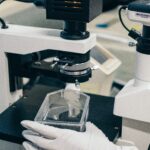 Angiodysplastic (AD) lesion is the most common cause of recurrent gastrointestinal (GI) bleeding in inherited Von Willebrand disease (VWD) patients lacking high-molecular-weight multimers. Defect or dysfunction of von Willebrand factor (VWF) may lead to enhanced endothelial cell proliferation followed by the development of neoangiogenesis and vascular malformation, which result in severe bleeding. Recurrent bleeding causing by GI AD is a challenging complication of VWD. The management of VWD could be difficult due to frequent recurrence and severity of bleeding episodes. The primary aim of management is not only to stop but also to prevent bleeding. We present two patients of type 3 VWD associated with AD and severe GI bleeding, which were successfully treated by endoscopic coagulation and prophylactic therapy with different regimens of plasma-derived VWF/factor VIII (pdVWF/FVIII) concentrate to maintain a trough level in the patient unresponsive to standard treatment. For more information click here.
Angiodysplastic (AD) lesion is the most common cause of recurrent gastrointestinal (GI) bleeding in inherited Von Willebrand disease (VWD) patients lacking high-molecular-weight multimers. Defect or dysfunction of von Willebrand factor (VWF) may lead to enhanced endothelial cell proliferation followed by the development of neoangiogenesis and vascular malformation, which result in severe bleeding. Recurrent bleeding causing by GI AD is a challenging complication of VWD. The management of VWD could be difficult due to frequent recurrence and severity of bleeding episodes. The primary aim of management is not only to stop but also to prevent bleeding. We present two patients of type 3 VWD associated with AD and severe GI bleeding, which were successfully treated by endoscopic coagulation and prophylactic therapy with different regimens of plasma-derived VWF/factor VIII (pdVWF/FVIII) concentrate to maintain a trough level in the patient unresponsive to standard treatment. For more information click here.
Publications
 Тази година 10-та Юбилейна национална конференция за редки болести и лекарства сираци ще се проведе под официалния патронаж на Министерството на здравеопазването.
Тази година 10-та Юбилейна национална конференция за редки болести и лекарства сираци ще се проведе под официалния патронаж на Министерството на здравеопазването.
В писмото си министъра на здравеопазването Кирил Ананиев изказва своето уважение към дейностите на Информационния център за редки болести и лекарства сираци. Той посочва още същественото значение на информираността при лечението на хората с редки болести и техните близки, с което се подобрява качеството им на живот. Министъра споделя, че със съвместни усилия могат да се подобрят условията за лечение на всички пациенти, включително и на хората с редки болести, чрез предоставяне на достъпна и достоверна информация за тези заболявания, както и за възможностите за лечение и рехабилитация.
Конференцията ще се проведе на 13-15 септември 2019 г. в Конгресен център на Международен панаир Пловдив. Основна тема на събитието ще бъдат новостите и актуалните тенденции в диагностиката, лечението и проследяването на редките болести, развитието на европейските референти мрежи и достъпа до иновации в областта на редки болести. Подробна информация за събитието, програмата и възможност за регистрация може да получите на официалната страница на събитието.

The Nobel Prize winner of the Medicine Award in 1993, Prof. Philip Sharp will visit “Alexandrovska” University Hospital. Prof.Sharp will give a lecture on “RNA interference and its medical applications” on 12th July 2019 at 11.00h in the “Maxima” auditorium of University Hospital “St. Ekaterina”, Sofia. The audience will include academic researchers, neurologists, specialistis in medical genetics, biology, chemistry and biochemistry. Representatives of patients’ organizations of people with rare diseases, journalists, medical professionals and others are also invited. There will be a discussion after the end of the lecture on which Prof. Sharp will answer questions from the audience. The press release of the event can be downloaded from this link.
The Relevance of Family History Taking in the Detection and Management of Birt-Hogg-Dubé Syndrome
 Birt-Hogg-Dubé syndrome (BHDS) is a rare autosomal-dominant inherited disorder characterized by inactivation of the gene Folliculin (FLCN), pulmonary cysts with recurrent spontaneous pneumothorax, dermatological lesions, and an increased risk of developing renal malignancies. We aimed to investigate the real prevalence of BHDS and its prevalence among patients with a familial history of pneumothorax. From July 2014 to December 2016, we consecutively studied all patients with spontaneous pneumothorax and a positive family history for the same condition referring to our Institution. The suspicious cases underwent genetic analysis of the BHDS-causative gene FLCN. FLCN-positive cases were further evaluated with routine blood tests, chest radiography, chest CT, abdominal MRI, and dermatological evaluation. Although BHDS is considered a rare disease, BHDS underlies spontaneous pneumothorax more often than usually believed, especially whenever a family history of pneumothorax is present. Diagnosis of BHDS is essential to start monitoring patients for the risk of developing renal malignancies. For more information click here.
Birt-Hogg-Dubé syndrome (BHDS) is a rare autosomal-dominant inherited disorder characterized by inactivation of the gene Folliculin (FLCN), pulmonary cysts with recurrent spontaneous pneumothorax, dermatological lesions, and an increased risk of developing renal malignancies. We aimed to investigate the real prevalence of BHDS and its prevalence among patients with a familial history of pneumothorax. From July 2014 to December 2016, we consecutively studied all patients with spontaneous pneumothorax and a positive family history for the same condition referring to our Institution. The suspicious cases underwent genetic analysis of the BHDS-causative gene FLCN. FLCN-positive cases were further evaluated with routine blood tests, chest radiography, chest CT, abdominal MRI, and dermatological evaluation. Although BHDS is considered a rare disease, BHDS underlies spontaneous pneumothorax more often than usually believed, especially whenever a family history of pneumothorax is present. Diagnosis of BHDS is essential to start monitoring patients for the risk of developing renal malignancies. For more information click here.
 Uncommon characteristics in genetically unsolved retinitis pigmentosa (RP) patients may indicate an incorrect clinical diagnosis or as yet unknown genetic causes resulting in specific retinal phenotypes. The diagnostic yield of targeted next-generation sequencing may be increased by a reasonable preselection of RP-patients. The participants in the study are one-hundred and twelve consecutive RP-patients who underwent extensive molecular genetic analysis. The methods, used in the study are characterization of patients based on multimodal imaging and medical history. Compared to genetically solved patients, genetically unsolved patients more frequently had an age of disease-onset above 30 years, showed atypical fundus features and indicators for phenocopies (eg, autoimmune diseases). Evidence for a particular inheritance pattern was less common. The diagnostic yield was 84% in patients with first symptoms below 30 years-of-age, compared to 69% in the overall cohort. The other selection criteria alone or in combination resulted in limited further increase of the diagnostic yield (up to 89%) while excluding considerably more patients (up to 56%) from genetic testing. The medical history and retinal phenotype differ between genetically solved and a subgroup of unsolved RP-patients, which may reflect undetected genotypes or retinal conditions mimicking RP. Patient stratification may inform on the individual likelihood of identifying disease-causing mutations and may impact patient counselling. For more information click here.
Uncommon characteristics in genetically unsolved retinitis pigmentosa (RP) patients may indicate an incorrect clinical diagnosis or as yet unknown genetic causes resulting in specific retinal phenotypes. The diagnostic yield of targeted next-generation sequencing may be increased by a reasonable preselection of RP-patients. The participants in the study are one-hundred and twelve consecutive RP-patients who underwent extensive molecular genetic analysis. The methods, used in the study are characterization of patients based on multimodal imaging and medical history. Compared to genetically solved patients, genetically unsolved patients more frequently had an age of disease-onset above 30 years, showed atypical fundus features and indicators for phenocopies (eg, autoimmune diseases). Evidence for a particular inheritance pattern was less common. The diagnostic yield was 84% in patients with first symptoms below 30 years-of-age, compared to 69% in the overall cohort. The other selection criteria alone or in combination resulted in limited further increase of the diagnostic yield (up to 89%) while excluding considerably more patients (up to 56%) from genetic testing. The medical history and retinal phenotype differ between genetically solved and a subgroup of unsolved RP-patients, which may reflect undetected genotypes or retinal conditions mimicking RP. Patient stratification may inform on the individual likelihood of identifying disease-causing mutations and may impact patient counselling. For more information click here.
 We present five Danish individuals with Hajdu-Cheney syndrome (HJCYS) (OMIM #102500), a rare multisystem skeletal disorder with distinctive facies, generalised osteoporosis and progressive focal bone destruction. In four cases positive genetic screening of exon 34 of NOTCH2 supported the clinical diagnosis; in one of these cases, mosaicism was demonstrated, which, to our knowledge, has not previously been reported. In one case no genetic testing was performed since the phenotype was definite, and the diagnosis in the mother was genetically confirmed. The age of the patients differs widely from ten to 57 years, allowing a natural history description of the phenotype associated with this ultra-rare condition. The evolution of the condition is most apparent in the incremental bone loss leading to osteoporosis and the acro-osteolysis, both of which contribute significantly to disease burden. For more information click here.
We present five Danish individuals with Hajdu-Cheney syndrome (HJCYS) (OMIM #102500), a rare multisystem skeletal disorder with distinctive facies, generalised osteoporosis and progressive focal bone destruction. In four cases positive genetic screening of exon 34 of NOTCH2 supported the clinical diagnosis; in one of these cases, mosaicism was demonstrated, which, to our knowledge, has not previously been reported. In one case no genetic testing was performed since the phenotype was definite, and the diagnosis in the mother was genetically confirmed. The age of the patients differs widely from ten to 57 years, allowing a natural history description of the phenotype associated with this ultra-rare condition. The evolution of the condition is most apparent in the incremental bone loss leading to osteoporosis and the acro-osteolysis, both of which contribute significantly to disease burden. For more information click here.
 Parry Romberg Syndrome or Progressive Hemifacial Atrophy is a rare disease usually affecting one side of face with loss of soft and hard tissues. The disease appears suddenly and is usually self-limiting in 2-10 years time. The loss of soft and hard tissue leads to aesthetic and functional deficits which are compounded by the presence of associated symptoms like neuralgia, migraine, epilepsy and ocular involvement. The degree of deformity depends on the age at which the disease manifests first; the younger the age, the more severe the deformity. These patients undergo severe psychological trauma and social problems. The exact etiology is not known, and treatment is largely cosmetic. A report of three cases and a literature review is presented. For more information click here.
Parry Romberg Syndrome or Progressive Hemifacial Atrophy is a rare disease usually affecting one side of face with loss of soft and hard tissues. The disease appears suddenly and is usually self-limiting in 2-10 years time. The loss of soft and hard tissue leads to aesthetic and functional deficits which are compounded by the presence of associated symptoms like neuralgia, migraine, epilepsy and ocular involvement. The degree of deformity depends on the age at which the disease manifests first; the younger the age, the more severe the deformity. These patients undergo severe psychological trauma and social problems. The exact etiology is not known, and treatment is largely cosmetic. A report of three cases and a literature review is presented. For more information click here.
 Kikuchi-Fujimoto’s disease KFD is a rare and benign cause of cervical lymphadenopathy. It is an anatomoclinical entity of unknown etiology. The confirmation of the diagnosis is always provided by histological lymph node study. The clinical picture sometimes evokes lymphoma or tuberculosis. The evolution is generally favorable with spontaneous healing after a few weeks. We report the case of a 26-year-old woman who had consulted for cervical lymphadenopathy associated with fever. The cervical lymph node biopsy concluded to Kikuch-Fujimoto’s disease. The evolution was marked by rapid regression of lymphadenopathy under corticosteroid treatment. For more information click here.
Kikuchi-Fujimoto’s disease KFD is a rare and benign cause of cervical lymphadenopathy. It is an anatomoclinical entity of unknown etiology. The confirmation of the diagnosis is always provided by histological lymph node study. The clinical picture sometimes evokes lymphoma or tuberculosis. The evolution is generally favorable with spontaneous healing after a few weeks. We report the case of a 26-year-old woman who had consulted for cervical lymphadenopathy associated with fever. The cervical lymph node biopsy concluded to Kikuch-Fujimoto’s disease. The evolution was marked by rapid regression of lymphadenopathy under corticosteroid treatment. For more information click here.
 Fabry disease (FD) is a multiorgan X-linked condition characterized by a deficiency of the lysosomal enzyme alpha-galactosidase A, resulting in a progressive intralysosomal deposit of globotriaosylceramide. The aim of this study was to evaluate the macular ultrastructure of the vascular network using optical coherence tomography angiography (OCTA) and to evaluate macular function using focal electroretinography (fERG) in Fabry patients (FPs). A total of 20 FPs (38 eyes, mean age 57 ± 2.12 SD, range of 27-80 years) and 17 healthy controls (27 eyes, mean age 45 years ± 20.50 SD, range of 24-65 years) were enrolled in the study. Color fundus photography, swept-source optical coherence tomography (SS-OCT), OCTA and fERG were performed in all subjects. The OCTA foveal avascular zone (FAZ), vasculature structure, superficial and deep retinal plexus densities (images of 4.5 × 4.5 mm) and fERG amplitudes were measured. Group differences were statistically assessed by Student’s t-test and ANOVA. OCTA vascular abnormalities and reduced fERG amplitudes indicate subclinical signs of microangiopathy with early retinal dysfunction in FPs. This study highlights the relevance of OCTA imaging analysis in the identification of abnormal macular vasculature as an ocular hallmark of FD. For more information click here.
Fabry disease (FD) is a multiorgan X-linked condition characterized by a deficiency of the lysosomal enzyme alpha-galactosidase A, resulting in a progressive intralysosomal deposit of globotriaosylceramide. The aim of this study was to evaluate the macular ultrastructure of the vascular network using optical coherence tomography angiography (OCTA) and to evaluate macular function using focal electroretinography (fERG) in Fabry patients (FPs). A total of 20 FPs (38 eyes, mean age 57 ± 2.12 SD, range of 27-80 years) and 17 healthy controls (27 eyes, mean age 45 years ± 20.50 SD, range of 24-65 years) were enrolled in the study. Color fundus photography, swept-source optical coherence tomography (SS-OCT), OCTA and fERG were performed in all subjects. The OCTA foveal avascular zone (FAZ), vasculature structure, superficial and deep retinal plexus densities (images of 4.5 × 4.5 mm) and fERG amplitudes were measured. Group differences were statistically assessed by Student’s t-test and ANOVA. OCTA vascular abnormalities and reduced fERG amplitudes indicate subclinical signs of microangiopathy with early retinal dysfunction in FPs. This study highlights the relevance of OCTA imaging analysis in the identification of abnormal macular vasculature as an ocular hallmark of FD. For more information click here.
 Although individually uncommon, rare diseases collectively account for a considerable proportion of disease impact worldwide. A group of rare genetic diseases called the mucopolysaccharidoses (MPSs) are characterized by accumulation of partially degraded glycosaminoglycans cellularly. MPS results in varied systemic symptoms and in some forms of the disease, neurodegeneration. Lack of treatment options for MPS with neurological involvement necessitates new avenues of therapeutic investigation. Cell and gene therapies provide putative alternatives and when coupled with genome editing technologies may provide long term or curative treatment. Clustered regularly interspaced short palindromic repeats (CRISPR)-based genome editing technology and, more recently, advances in genome editing research, have allowed for the addition of base editors to the repertoire of CRISPR-based editing tools. The latest versions of base editors are highly efficient on-targeting deoxyribonucleic acid (DNA) editors. Here, we describe a number of putative guide ribonucleic acid (RNA) designs for precision correction of known causative mutations for 10 of the MPSs. In this review, we discuss advances in base editing technologies and current techniques for delivery of cell and gene therapies to the site of global degeneration in patients with severe neurological forms of MPS, the central nervous system, including ultrasound-mediated blood-brain barrier disruption. For more information click here.
Although individually uncommon, rare diseases collectively account for a considerable proportion of disease impact worldwide. A group of rare genetic diseases called the mucopolysaccharidoses (MPSs) are characterized by accumulation of partially degraded glycosaminoglycans cellularly. MPS results in varied systemic symptoms and in some forms of the disease, neurodegeneration. Lack of treatment options for MPS with neurological involvement necessitates new avenues of therapeutic investigation. Cell and gene therapies provide putative alternatives and when coupled with genome editing technologies may provide long term or curative treatment. Clustered regularly interspaced short palindromic repeats (CRISPR)-based genome editing technology and, more recently, advances in genome editing research, have allowed for the addition of base editors to the repertoire of CRISPR-based editing tools. The latest versions of base editors are highly efficient on-targeting deoxyribonucleic acid (DNA) editors. Here, we describe a number of putative guide ribonucleic acid (RNA) designs for precision correction of known causative mutations for 10 of the MPSs. In this review, we discuss advances in base editing technologies and current techniques for delivery of cell and gene therapies to the site of global degeneration in patients with severe neurological forms of MPS, the central nervous system, including ultrasound-mediated blood-brain barrier disruption. For more information click here.
